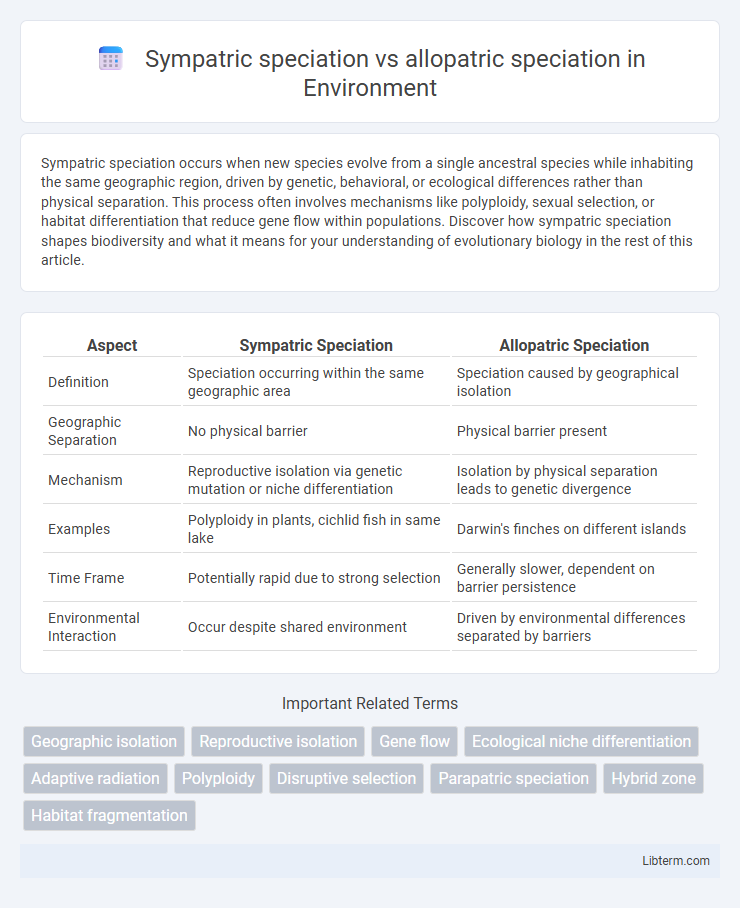Sympatric speciation occurs when new species evolve from a single ancestral species while inhabiting the same geographic region, driven by genetic, behavioral, or ecological differences rather than physical separation. This process often involves mechanisms like polyploidy, sexual selection, or habitat differentiation that reduce gene flow within populations. Discover how sympatric speciation shapes biodiversity and what it means for your understanding of evolutionary biology in the rest of this article.
Table of Comparison
| Aspect | Sympatric Speciation | Allopatric Speciation |
|---|---|---|
| Definition | Speciation occurring within the same geographic area | Speciation caused by geographical isolation |
| Geographic Separation | No physical barrier | Physical barrier present |
| Mechanism | Reproductive isolation via genetic mutation or niche differentiation | Isolation by physical separation leads to genetic divergence |
| Examples | Polyploidy in plants, cichlid fish in same lake | Darwin's finches on different islands |
| Time Frame | Potentially rapid due to strong selection | Generally slower, dependent on barrier persistence |
| Environmental Interaction | Occur despite shared environment | Driven by environmental differences separated by barriers |
Introduction to Speciation
Speciation occurs when populations of the same species diverge into distinct groups unable to interbreed, driven by genetic differentiation and reproductive isolation. In sympatric speciation, new species arise within the same geographic area through mechanisms like polyploidy or behavioral isolation, enhancing genetic divergence without physical barriers. Allopatric speciation involves geographic isolation, such as mountains or rivers, which separates populations and prevents gene flow, leading to distinct evolutionary paths over time.
Defining Sympatric Speciation
Sympatric speciation occurs when new species evolve from a single ancestral species while inhabiting the same geographic region, driven by genetic, behavioral, or ecological factors that prevent interbreeding. Unlike allopatric speciation, which requires physical barriers such as mountains or rivers separating populations, sympatric speciation relies on mechanisms like polyploidy in plants or niche differentiation in animals. This process exemplifies how reproductive isolation and genetic divergence can arise without geographic isolation, leading to speciation within overlapping environments.
Defining Allopatric Speciation
Allopatric speciation occurs when a population is geographically separated, leading to reproductive isolation and genetic divergence over time. Physical barriers such as mountains, rivers, or distances prevent gene flow, causing populations to evolve independently through mutation, selection, and genetic drift. This form of speciation contrasts with sympatric speciation, where new species arise within the same geographic area without physical separation.
Key Differences Between Sympatric and Allopatric Speciation
Sympatric speciation occurs without geographic isolation, where new species evolve within a shared habitat through mechanisms like polyploidy, behavioral changes, or ecological niche differentiation. Allopatric speciation involves geographic separation, leading to reproductive isolation and divergence due to physical barriers such as mountains or rivers. Key differences include the presence of physical barriers in allopatric speciation versus genetic divergence within the same location in sympatric speciation, resulting in different modes of species formation and evolutionary pathways.
Mechanisms Driving Sympatric Speciation
Sympatric speciation occurs when new species evolve from a single ancestral population without geographic isolation, primarily driven by mechanisms such as polyploidy, habitat differentiation, and sexual selection. Genetic mutations causing reproductive isolation within the same environment allow sympatric populations to diverge through assortative mating and ecological niche specialization. In contrast, allopatric speciation involves physical barriers like mountains or rivers that separate populations, leading to genetic divergence through limited gene flow and independent evolutionary paths.
Mechanisms Driving Allopatric Speciation
Allopatric speciation is driven primarily by geographic isolation that physically separates populations, preventing gene flow between them. Over time, environmental differences and genetic drift lead to divergence in traits and reproductive barriers, resulting in the formation of new species. This isolation mechanism contrasts with sympatric speciation, where reproductive isolation arises within a shared habitat without physical barriers.
Examples of Sympatric Speciation in Nature
Sympatric speciation occurs when new species evolve from a single ancestral species while inhabiting the same geographic region, exemplified by cichlid fish in African rift lakes adapting to different ecological niches without physical barriers. Another well-documented case involves apple maggot flies (Rhagoletis pomonella) shifting from hawthorn to apple hosts, leading to reproductive isolation. These examples highlight how genetic divergence and ecological factors drive speciation despite ongoing gene flow.
Examples of Allopatric Speciation in Nature
Allopatric speciation occurs when populations of a species are geographically separated, leading to reproductive isolation and genetic divergence. Classic examples include Darwin's finches in the Galapagos Islands, where volcanic activity created distinct islands that fostered species differentiation. Similarly, the Kaibab squirrel and Abert's squirrel on opposite rims of the Grand Canyon demonstrate allopatric speciation driven by physical barriers.
Evolutionary Implications of Speciation Types
Sympatric speciation, occurring without geographic barriers, promotes genetic divergence through mechanisms such as polyploidy and disruptive selection, driving reproductive isolation within overlapping populations. Allopatric speciation, characterized by physical separation, fosters evolutionary divergence via habitat fragmentation and genetic drift, resulting in distinct lineages adapted to different environments. These speciation types fundamentally shape biodiversity by influencing gene flow, adaptation rates, and the emergence of new species under varying ecological contexts.
Conclusion: Significance of Speciation Models
Sympatric speciation illustrates how new species can arise within a shared habitat through mechanisms like polyploidy or behavioral isolation, emphasizing the role of genetic divergence without geographical barriers. Allopatric speciation, driven by geographic isolation, highlights the impact of physical separation in preventing gene flow and fostering evolutionary divergence. Understanding both models is crucial for comprehending biodiversity patterns and guiding conservation strategies in diverse ecosystems.
Sympatric speciation Infographic

 libterm.com
libterm.com